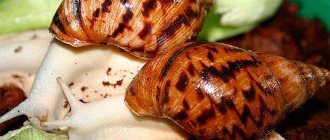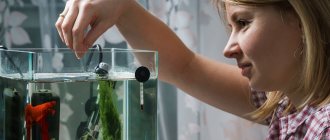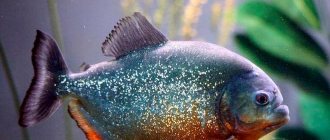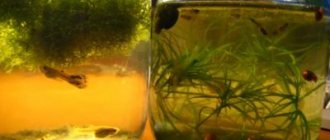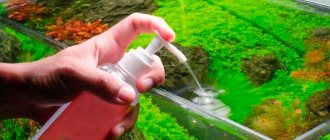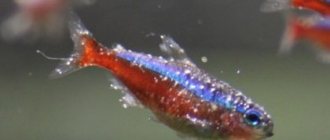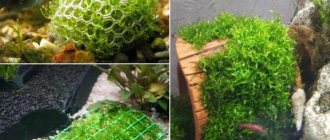DIY hatchery for fry
Why do you need a depositor?
If the fish give birth to fry, then the condition of the aqua is quite satisfactory. Consequently, sooner or later the owner of ornamental fish is faced with the problem of preserving the young. The fact is that tiny fry are excellent food for almost all adults.
If the juveniles are not removed in time, isolating them from the rest of the inhabitants of the aquarium, then they will be eaten in the shortest possible time. Some aquarists place the fry in separate trays or jars.
A special fish tank for fry located directly in the general aquarium can successfully solve the problem of their preservation and subsequent growth. Before spawning, adult fish are placed there, and immediately after the offspring appear, the parents are moved back to the common aqua. Only kids remain in the detention center.
Before you start making a depositor with your own hands, it would be a good idea to familiarize yourself with the existing types of these devices.
Types of sedimentation tanks
The simplest do-it-yourself fish tank for fry
The material for making a quarantine mini-aquarium for juveniles at home can be a simple transparent plastic mineral water bottle. Juice or drink bottles are not suitable: plastic may contain molecules of foreign chemicals.
First you need to remove the label and thoroughly rinse off any remaining glue. The top part of the bottle (about 1/3 of its height) is cut off, but not all the way. It is necessary to leave a piece of plastic approximately 3-5 centimeters wide to make the handle of the future depositor.
The improvised handle must be bent in half, the bend must be heated over a fire, preventing complete melting, and fixed in the form of a kind of hook. The height of the future homemade fish tank and the size of the hook must be selected so that the edges of the plastic house for the fry are above the level of the aquarium water.
For the subsequent operation you need to be patient. A thick needle or thin awl is used to pierce many holes in the plastic of the bottle. Aquarium water will flow through them. Holes should not be made along the entire circumference, but on one side (about ¼ of the surface). There is also no need to pierce the bottle all the way to the bottom: when changing the water, if necessary, the water with the fry will remain in the lower part.
If you make holes from the outside, then inside this container there will be notches like a fine grater. A female that moves sharply from side to side during spawning can be seriously injured. And such a grater can also cause injury to juveniles. But for adults swimming in the main aquarium, the ribbed plastic surface is completely safe.
The homemade fish tank for fry is ready. It is suspended from the wall of the aquarium so that air bubbles from the aerator enter it. Flows of water and air, pushing off from a solid wall, create the environment necessary for juveniles in the hatchery. Of course, you need to clean the holes from debris and algae in a timely manner.
Some aquarists use plastic containers that float freely in the aquarium as an impromptu aquarium. But the principle remains the same: the presence of holes on one or both sides of the container for aeration and water circulation.
Experience shows that solid-walled fish tanks are much safer for juveniles than net-based systems. Making a simple plastic kindergarten for fry will require only 30-40 minutes of time and a little patience.
For those who do not want to make a hatchery for fry with their own hands, we suggest watching a video review of a ready-made solution from a pet store:
How fish reproduce in an aquarium - a fascinating underwater world in our home
An aquarium is often the main decoration of any home. Pisces, as its main inhabitants, are able to transform any indoor pond into a colorful underwater world, bringing joy and tranquility to its owners.
Many aquarists consider breeding aquarium fish one of the most exciting activities. It seems that it could be simpler: we bought an aquarium, put several different individuals in it - and we can calmly wait for new “guests”. But there are many nuances to this issue.
Variety of aquarium fish and their breeding
First you need to decide how many fish to add to the aquarium and what size they will be. Then the most interesting part begins: in order for the underwater inhabitants to feel comfortable and not crowded in the aquarium, you need to correctly determine its volume, take into account how different individuals can get along with each other so that they do not eat each other.
An important role is played by the choice of decorative elements that make the shelter cozy and the aquarium beautiful and attractive. In the process of breeding various species in artificially created conditions, you can follow their interesting life. For example, how fish reproduce or how they feed, how they behave in different situations.
The varieties of aquarium fish are very diverse. Residents of freshwater aquariums are primarily divided into cold-water and warm-water.
Keeping cold-water species in aquariums is difficult because they constantly suffer from a lack of oxygen. It dissolves much less in warm water than in cold water, and in our rooms it usually has a fairly high temperature.
Most aquariums contain mainly warm-water exotic individuals that live naturally in fresh, sometimes brackish waters of the tropics and subtropics. These representatives are distinguished by their small size, bright color and ability to live at a constant temperature of at least 20 degrees.
Not all types of fish can exist in the same water layers. For example, catfish live at the bottom, and viviparous guips live in the middle waters. There are also those that inhabit only the upper layers. Such dispersal into tiers depends on their demand for oxygen, which is more abundant at the surface of the reservoir.
In recent years, marine aquariums have become popular, housing representatives of coral reefs and some other inhabitants of warm seas.
Fish reproduction
For aquarium lovers, it will not be difficult to ask the question: how do fish reproduce?
Basically, everyone has the same method - laying eggs. Some species throw
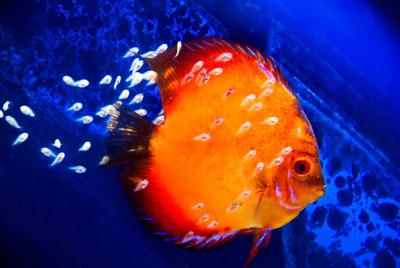
eggs in deep water: eggs fall onto plants or soil. Others prefer to spawn in different layers of water or in thickets of plants. Their eggs are often attached to stems and leaves. Still others, such as cichlids, lay their eggs on rocks.
There are fish that make a spawning nest in the sand, under stones, under plants or in their roots. Interesting are representatives of some genera, which, jumping out of the water, place eggs on plants outside of it. Labyrinthine species construct nests from air bubbles on the water surface, and some species use small pieces of plants for this.
Most tropical inhabitants of aquariums tend to reproduce throughout the year, since their natural habitat conditions favor this. And many northern individuals and individual groups of goldfish spawn only in autumn, summer and spring.
In fact, there are no particular differences in how fish reproduce in natural and artificial environments. It is only worth noting that creating a favorable environment for spawning in the aquarium can become an incentive for reproduction. They can serve as a decorative pot, a large stone or some plant.
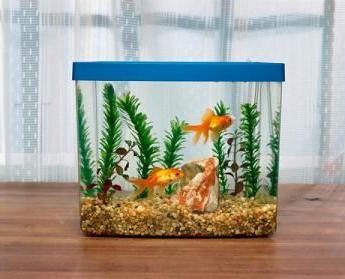
Before spawning, many species perform a mating ritual in the form of games. Watching representatives of the water element at this time is a great pleasure.
Aquarium hobbyists do not always have sufficient knowledge and skills in this area. In fact, all the secrets of breeding are publicly available and many of them are contained in specialized literature, which describes in detail how fish reproduce, their numerous species, methods of care, food, and much more.
Anyone can create a decorative aquarium that can become a highlight in the decoration of an apartment or office, giving the room beauty and originality. The main thing is to have a great desire for this!
How to care for baby guppies
Rules for keeping fry in a hatchery
Keeping guppy fry is possible in a specially prepared nursery. It is recommended to take a glass container with a volume of 20-50 liters - in such a tank, caring for baby fish will not cause trouble for the aquarist. Water must be taken from the community aquarium where these fish were born. There are often reports that guppy fry died after being released into the hatchery. This is due to the fact that the water in it had unsuitable parameters. Ground cover, stones and driftwood are optional, as they do not make caring for a guppy brood any easier.
See how to make a simple hatchery for fry with your own hands.
You need to install a filter and a compressor in the sedimentation tank. A sponge filter connected to a compressor is suitable as a filter. To maintain the temperature, you will need a water heater. For lighting, it is better to choose fluorescent lamps that do not heat the water too much.
Water changes should be carried out in an amount of 20-40% of the volume of the depositor. You also need to siphon the bottom, preferably after a water change. The filter sponge should be rinsed once a week, depending on the degree of clogging. Aeration and water filtration should be turned on 24 hours a day. The replacement water must be infused for 2-3 days.
In the first days of life, the amount of daylight should be 12 hours, gradually reducing it. At the age of 3-4 months, small fish will need 8-10 hours of light. Saturated lighting increases the rate of growth and development. The best water temperature in the hatchery: 28°C for the first 3 days of life. The temperature gradually decreases to 26°C, after 3-4 months to 24°C.
Feeding. First sexual signs
Proper care is impossible without feeding. For the first 3 weeks of life, they can be fed live dust and brine shrimp with an incubation period of 6-8 hours. In the first month of life, you can add bloodworms, chopped tubifex, and cyclops to the diet. It is important that the feed is crushed. You can also feed hard-boiled and chopped chicken yolk, alternating it with other foods. It is recommended to provide branded food for guppy fry.
Look at the newly born guppy fry.
As the fry grow older, they need to be sorted. When it is possible to identify the sex, especially of mature guppies, prepare an aquarium with water, diluting it with water from the fish tank. Guppies can breed from the age of 2-4 weeks, so to avoid early pregnancy of females, sorting should be done.
The dominant feature of male guppies in the early stages is the elongation and folding of the lower fin, which is located near the anus. Over time, this fin will develop into a gonopodium. Once the gonopodium is formed, it will be easier to determine the sex in the early stages. Raising fry of different sexes is good for their health. When kept separately, it is easier to care for them, and they do not waste their energy chasing each other.
If the fry do not take food during feeding, it means that the water quality does not meet the standards. Healthy fry have a rounded abdomen and a strong appetite. Many problems with raising fry are due to the fact that they are not properly cared for. This applies to cleaning the aquarium (bottom siphon, water changes, filtration, aeration).
The first signs of coloring in baby fish do not appear immediately, depending on the species or breed. Sometimes a female guppy is able to give birth to offspring from different males, or once fertilized, a female may give birth every month. The number of fry in one brood is about 20. Therefore, it happens that fry from several broods grow in an aquarium. The first time after birth, the fry can remain motionless at the bottom.
If you do not properly care for the female during pregnancy, she may give birth to premature fry ahead of schedule, in which the yolk sac will be visible. Premature birth of a female occurs due to frequent water changes in the aquarium, or due to the introduction of guppies into a recently started aquarium. The mortality rate among premature fry is very high.
Reproduction of swordtails in captivity
How to create optimal conditions for reproduction?
Preparing fish and spawning grounds for reproduction
In order for the offspring to turn out beautiful and healthy, you should select the right males and females for spawning. Males should be 8 months old, their caudal fin should be distinguished by a long lower ray, and their gonopodium should increase in size. The female should be 8-10 months old, large in size and have a rounded abdomen, which indicates readiness to reproduce.
Fertilization of the swordtail fish is intrauterine. If fertilization has occurred, some of the male’s sperm will remain in the female’s abdominal cavity, which will fertilize the female again, without the participation of a male. Therefore, if you get yourself a swordtail, you should know that these fish can produce offspring every month. During one spawning, the female swordtail will give birth to 50-200 fry.
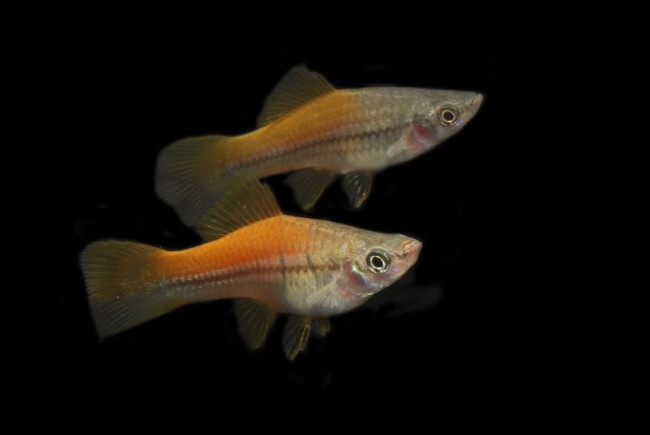
Why exactly this amount? The fact is that young females bring fewer offspring, mature ones - more, and with each birth the number of fry will increase. Also, the number of babies depends on the species and conditions of keeping the fish. Pregnancy lasts 4-6 weeks, the female’s abdomen will become round, and before giving birth it will become almost square in shape. A month before birth, you need to prepare a spawning tank.
A container of 25-50 liters with infused tap water is suitable as a spawning tank. It is recommended to plant small-leaved vegetation at the bottom of the tank, in which the fry will hide. After preparing the spawning area, a female is released into it and fed with live food. After the birth of the babies, the female fish is placed in a common aquarium so that she does not eat her brood. To delicately catch a female, use a net.
Watch how the swordtail fry are born.
Can swordtails change their gender?
AkvariumnyeRybki.ru>
A fish tank for fry in an aquarium
Every fairly experienced aquarium fish lover has at least once encountered situations where adult fish eat their fry. It is for this reason that experts recommend placing the expectant mother in a separate container for the safety of the fry. But such a solution to the problem not only causes additional trouble for the aquarist, but also the fish, due to the lack of proper conditions, feel uncomfortable, waste away and get sick. The way out of this situation was a hatchery for guppies and other viviparous fish.
In every pet store you can find two main modifications of depositors:
- the walls of which are made of fabric;
- with hard, most often plastic, walls.
Based on the experience of experienced aquarists, aquariums with solid walls are much safer for your pets. Primarily due to the fact that predatory fish can eat the fry through the fabric. There are also situations when small fish become entangled in the folds of fabric and suffocate there. Therefore, you should buy or make your own a depositor with solid walls.
How to make a hatchery for fry?
The simplest and cheapest base you can think of for a depositor is a plastic bottle. You need to cut off the neck from it. But this needs to be done so that at the top of the resulting glass there remains a “tail” about 4 cm wide and 7-10 cm long. You can make a convenient hook from it in order to hang the glass on the edge of the aquarium. And the most important thing that should be done for the glass to become a depositor is to use a needle to make many holes through which water can circulate.
It is advisable to place the fish tank in a general aquarium close to the sprayer for better ventilation. Now the fry will be in an aquarium with water at the required temperature, enriched with oxygen, etc., but at the same time in complete safety.
Aquarium swordtail fish: reproduction and maintenance
Swordtails are very popular among both professional aquarists and hobbyists. But before you get these bright fish, it is better to find out the details of care, breeding, compatibility with other types of fish, etc.
The natural habitat of swordtails is Central America and Southern Mexico. These fish were given such an interesting name because of the unique shape of their fin. Only males have it and use it for reproduction. The surprising thing is that female swordtails can change their sex by growing a sword fin, and even in this state give birth to offspring. They range in length from 8 to 12 cm, not counting, of course, their fin. Swordtails live for about 4-5 years.
Swordtails - aquarium fish: types
Fish aquarium
Aquarium swordtail fish: compatibility with other species
These are, in general, quite calm fish; they sort out relationships only among themselves, so you can keep them in the same container with other species. The only thing is that they can be aggressive towards smaller fish.
Barbs, cockerels, discus, tetras, labeos, guppies, and gourami get along well with swordtails.
Eels and shrimps are not a very good combination with them, but cichlids, goldfish and astronotuses are completely incompatible with swordtails.
Reproduction
Diseases
aquariumguide.ru>
Maternity ward for fish
Arrangement
For fish that scatter eggs
For fish that stick eggs
For cichlids
For labyrinths
For carp-toothed
For fish that incubate their offspring in the mouth
Spawning methods
On the leaves
In a foam nest
On glass
Out of water
In a common aquarium
This type of spawning can be used when keeping one type of fish, peaceful in nature, like cardinals and palmeri. It is best to fence off a third of the container with a separator net, where Java moss and small-leaved plants are laid out at the bottom of most of it.
Spawning species
For viviparous
Pearl gourami care spawning photo video reproduction description
GURAMI CARE CONTENTS DESCRIPTION SPAWNING COMPATIBILITY.
Reproduction of aquarium fish pearl gourami
If male gouramis begin to build a foam nest, they are ready to breed. Usually this happens at the age of one year. The male can and should be helped. Firstly, the water level in the aquarium during this period should not exceed 15 cm. Secondly, it needs building materials - therefore it is advisable to put small floating plants in the spawning tank. They will also help the female to hide from the annoying advances of the male after spawning.
Gourami can also breed in a community aquarium. But if this does not happen, then reproduction must begin by “moving” the male from the main aquarium to the spawning area. In a spawning tank with a volume of 15-20 liters there must be standing water so that the built nest does not collapse, the water temperature is heated to 28-29°C.
The male spends all his time around the nest, the diameter of which reaches 7 cm. This is the future place for offspring. When the male has already acquired such a place, the female is transplanted to him.
A pregnant gourami looks like other pregnant fish - it has a rounded abdomen. And the male sees this. If the female is ready for spawning, then he immediately begins to court her in every possible way, changes color and becomes especially beautiful. If the female is not ready, she can drive her until she loses her tail and fins, or even to death. Before spawning, spawners are heavily fed.
Mating process of pearl gourami
Raising gourami fry
PEARL GURAMI Characteristics of external features
PEARL GURAMI Habitat Features
PEARL GURAMI Appearance
aquarium-fish-home.ru>
Spawning aquarium, spawning tank
The spawning aquarium is designed specifically for hatching fry at home. In a community aquarium, reproduction of fish is practically impossible, since the adult inhabitants eat the young.
Spawning tank
The aquarium for hatching fry must meet all the requirements for it. First of all, these are temperature, lighting, water filtration. For the spawning tank, a standard foam filter is used. It must be equipped with agrophila - a spherical plant that saturates the water with oxygen. In addition, it purifies water naturally. It is not recommended to use filters of a different design for spawning aquariums, as there is a possibility of an error in the size of its cells. This risks the fry getting stuck in the filter base material.
You should not intensively fill the bottom in which spawning will take place with soil and overload it with aquatic plants. This type of tank is much easier to maintain. However, it is important to remember that the conditions in the tank for raising fry should be as close to natural as possible.
Spawning species
When and how do zebrafish reproduce?
Sexually mature Danio: description
The pink zebrafish and zebrafish become sexually mature when they reach their maximum body size. At water temperatures above 25°C, the rate of maturation accelerates. At home, fish become ready for reproduction at 75-80 days of life, when the body length of females becomes 25 mm, and males - 23 mm.
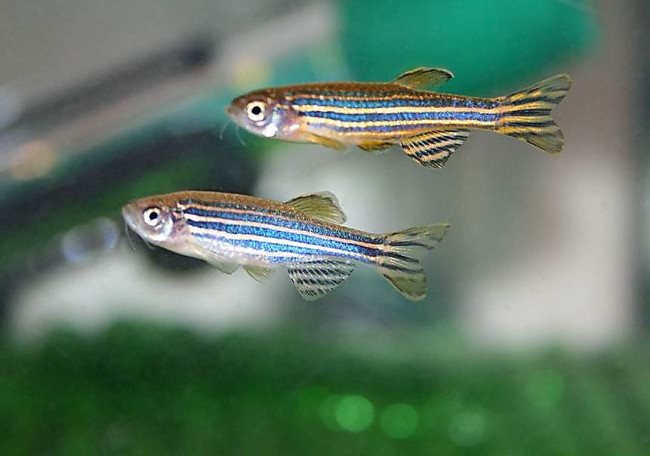
Ovulation of females living in a community aquarium largely depends on the influence of male hormones that are released from the gonopodium. Males splash into the water a fraction of the gonads and a homogenate of the testes, which contain steroid compounds of glucuronic acid. They also cause ovulation in females.
If males are present in the aquarium for 8 hours, then breeding will begin in the morning. Females that are kept in isolation for 5 days will not produce eggs. Mature eggs are produced during one spawning cycle. If different-sex individuals are kept comfortably in the tank, they will begin to reproduce in any case, and the intervals between spawnings can be one week. The water temperature that stimulates the process is 22-27 degrees Celsius.
See how to prepare an aquarium for breeding zebrafish.
Have you noticed that adult fish cannot spawn in a community aquarium? Pay attention to their content. The reasons for the lack of spawning may be the following factors:
- Diseases of fish of fungal or bacterial origin;
- Absence of males in the reservoir;
- Insufficient supply of live food to the fish;
- Old age of fish, or their young age;
- Solidification of eggs in the abdomen of the female.
Now you need to understand how to distinguish between sexually mature males and females. All types of zebrafish (rerio, pink, malabar, pearl and others) have almost identical characteristics that determine gender. The differences between them are:
- Females are larger than males and have a rounded belly;
- On the body of females, the horizontal stripes are faded, as is the general color of the scales;
- During the spawning period, females are calm and slow, and males are active and playful;
- With the arrival of spawning, the body color of males becomes brighter, the stripes become saturated with color.
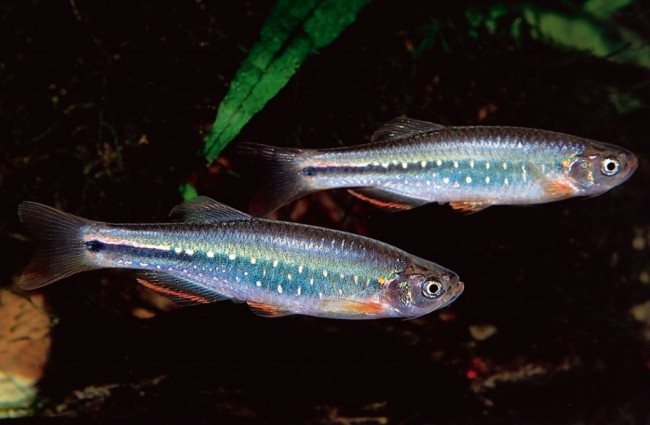
How does the reproduction process occur in pink danios?
The pink zebrafish is an easy fish to breed, but it also requires special preparation before breeding. The first step is to determine the sex of all the fish and place them in separate containers with infused water for 2 weeks. The second step is abundant feeding of future producers with live food (bloodworms, brine shrimp, daphnia, coretra, tubifex).
If fish begin to breed within the walls of a community aquarium, immediately transfer them to the spawning tank. Otherwise, spawners and other adult fish will eat the eggs. In the hatchery, males and females will continue to spawn.
Pink zebrafish spawn better in a separate tank. Preparing it is not difficult: select a glass container with a volume of 40-50 liters, pour into it clean and pre-infused tap water with an acidity of 7.0 pH and a hardness of up to 15o. A spacious tank will not hamper the movements of the fish, which are already very fussy at this time. Aeration of water is allowed.

It is not recommended to install decorations in the form of soil, stones, wooden snags or caves in the spawning area. The only substrate for spawning can be plants: Javanese or Thai moss, cirrus, and Canadian elodea. To prevent the plants from floating, they can be pressed to the bottom with small stones (clean pebbles treated with boiling water). To preserve eggs, place a fine mesh separator net on top of the plant at a level of 2 cm from the bottom. It will protect the eggs from adult fish.
First, a female is introduced into the spawning aquarium and fed live food for 2 days. When her abdomen is as round as possible, you can introduce 2-3 males and turn off the lights at night. You can place two females and 4-5 males.
Breeding will begin in the morning. Fish can mate for several hours. During this time, the female will be fussy and active, leaving behind a lot of eggs (1000-2000 pieces). They will all sink to the bottom, passing through the mesh. Young females can spawn fewer eggs - from 100 eggs or more.
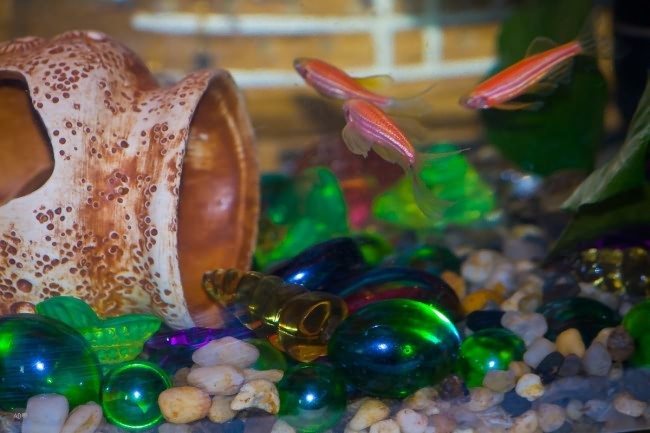
Upon completion of spawning, the producers need to be transplanted into a common aquarium. The mesh can be removed from the bottom, and if caviar is stuck between the fishing line, it must be lightly shaken off. After 24-72 hours, the first larvae may hatch. After three days the fry will swim on their own. Starter food – ciliates, live dust, branded food for zebrafish fry.
How does Danio rerio spawn?
AkvariumnyeRybki.ru>
